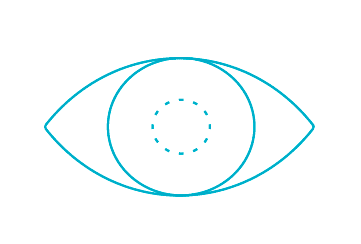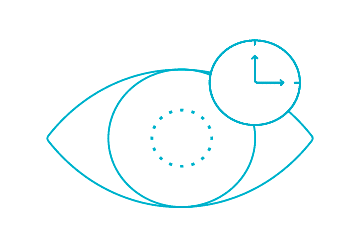

Implantable Contact Lens (ICL)
An ICL is also known as known as phakic IOL (or phakic intraocular lens). It is performed to treat short-sightedness (also known as near-sightedness or myopia)
An ICL is ideal for individuals under 40 years of age who do not yet need reading glasses. The implanted lens is most commonly placed behind the iris and in front of the natural crystalline lens of the eye. It is designed to last for life, and can be easily removed in the at a later stage in life if cataract surgery is required. An ICL corrects short-sightedness (myopia), significantly improving one’s vision without glasses.
Treatment is tailored to the individual to facilitate the best possible vision that will suit their lifestyle requirements. It is important to bear in mind that there is no perfect solution to match all lifestyle needs. During the consultation, the surgeon will help you pick an option that is most suitable for you.
Sharp, Clear Vision
99%
Patient satisfaction
1,000,000
Procedures worldwide
Excellent night vision
A removable, upgradable option
Great for those with thin corneas
Does not induce dry eye syndrome
In harmony with your natural eyes

Flexibility for the Future

No Dry Eye Syndrome

Removability

A Quick Procedure and Recovery
A removable, upgradable option
Great for those with thin corneas
Does not induce dry eye syndrome
In harmony with your natural eyes
ICL Surgery
Following are some major factors that decide a patient’s eligibility for ICL surgery-
ICL surgery is suggested when the refractive error stays within a range from -0.5D to -20D in Myopia and up to -3D in astigmatism. Patients with age between 21-45 years are ideal candidates for ICL surgery as approved by the FDA (American Food and Drug Administration). However, the type of Implantable Collamer Lens suitable further depends on the degree of Myopia or hyperopia, or astigmatism patients have prior to ICL surgery.
Unlike LASIK surgery, Patients with a thin cornea, corneal irregularities (or keratoconus) or even a history of unsuccessful Refractive surgery in the past are also eligible for ICL surgery. But pregnant and lactating females are not eligible as hormonal changes during pregnancy and lactation can cause changes to corneal curvature and its thickness thereby affecting the success rate of ICL surgery in the first place.
Visit our London facility for a one-to-one consultation with an expert ophthalmologist.
Implantable Contact Lens procedure is commonly followed to treat different kinds of refractive errors. That’s why ICL surgery is highly recommended for patients who are not fit for Lasik due to large pupils, thin/ irregular cornea or have severe dry eyes. Implantable Contact Lens is made up of Collamer, purified collagen with a very soft and flexible texture. Thus, they are highly biocompatible and prone to any eye infection. The Collamer material is the main reason why ICL lenses are also called Implantable Collamer Lens. However, that’s not the only benefit. There are more to it.
ICL surgery takes less than 30 minutes with topical anesthesia thus offers a very minimal discomfort. You can see the improvement in your vision on the same day of ICL surgery. However, expect a major improvement within a week.
Implantable Contact Lens are an excellent option to minimise the risk of halos and glare effects caused by other lenses. In fact, your night vision may improve because of the UV blockers used inside the lens. Even on the brighter side, the Implantable Collamer Lens can be easily removed in lieu of any better alternative in the future that you may like to opt for either in London or anywhere in the world.
In this regard, you can visit our London eye clinic to discuss more your eligibility criteria.
These are some commonly followed steps for ICL Surgery everywhere-
You will be asked to lie down on your back and will be administered topical or local anesthesia to numb your eye before the ICL surgery. Doctors clean your eyes and the area around them with a disinfectant. They may also give an injection to prevent the movement of the eyes while inserting the Implantable Collamer Lens.
Through a tiny incision, doctors will insert the Implantable Contact Lens into your eye. Being an extremely thin lens, it is first folded during insertion and then gets unfolded inside. After successfully inserting the Implantable Collamer Lens, doctors will stitch the operated part, and will apply some antibiotic drops and ointments to your eye before covering it with an eye patch. You will be under observation for the next 1-2 hours post-surgery to closely monitor your intraocular pressure.
After post-op care, you will be discharged on the same day. Doctors will prescribe you some medications with taper doses. You will be advised for periodic follow-ups for the next three months until everything is set back to normal. At our London facility, we follow best practices in ICL surgery to offer you world-class treatment.
Book an Appointment
Frequent asked questions (FAQs):
ICL surgery does not involve removing any cornea tissue from the eye, unlike laser refractive surgery. ICL surgery simply involves making small keyhole incisions and inserting a lens into the eye. This means that ICL surgery is reversible by removing the ICL. ICL surgery is safer for individuals who are highly short-sighted (range of -6 to -20). In fact, there is emerging evidence that it may be a better option than laser refractive surgery for individuals with even lower levels of short-sightedness.
ICL surgery corrects short-sightedness, giving you much more clear vision without spectacles or contact lens.
In the hands of an experienced surgeon, the operation takes 5-10 minutes. The patient can go home immediately after routine surgery, and vision usually improves significantly within a few days.
Yes, at the Harley Vision, refractive lens exchange surgery can be performed on both eyes on the same day.
ICL surgery has a good safety profile, and can transform quality of life. The most common complications are over or under-correction, whereby an individual ends being slightly more short or long-sighted than intended. This is correctable by replacement of the ICL. Risk of severe loss of vision due to complications such as infection or retinal detachment are rare, and the majority of patients are very happy with surgical outcomes.
You will meet your surgeon, Mr Mukhtar Bizrah, who will discuss the options of correcting your vision and perform your eye surgery. At the Harley Vision, you will not meet your surgeon for the first time on the day of surgery!
ICL surgery comes with mild discomfort caused by an instrument to prevent eye blinks and a minor incision to the cornea during the procedure. On the overall, it’s a painless procedure.
An ICL surgery typically takes 15-30 minutes but may vary depending on various factors such as the application of anesthetic drops and other pre-operative measures.
As the lenses are made up of improved collagen that is highly biocompatible and is prone to any infection, they can last up to 90 years.
Yes, you can. Depending on the refractive error and the thickness of your cornea, our doctors in London may either operate both eyes simultaneously or may go phase-wise with two weeks of observation gap in between.
As the Implantable Contact Lens gets implanted in the anterior chamber, doctors will constantly check for any high Eye Pressure (IOP or Intraocular Pressure) after the surgery. If it is high, you will be prescribed some medicines, eye drops, and oral tablets to lower the pressure. An eye shield also might be provided to protect eyes from dust and an accidental touch of hands.
Yes, even after a successful ICL surgery at our facility in London, you may still need reading glasses for your presbyopia or for improving your near vision after the age of 40.
Though you can resume normal duties within a week of the ICL surgery, it is advisable not to drive or do any heavy physical activity for the next 8-10 days. However, that’s just an average timeline for recovery. The recovery period may vary from patient to patient, depending upon the complications.
At AI Vision, you receive quality treatment under highly experienced ophthalmologists of London who use State-of-the-Art diagnostic devices to offer accurate and comprehensive treatment. Plus, we make use of Artificial intelligence (AI) to optimize treatment outcomes. We are tied up with 12+ insurance companies in London to give you peace of mind not just for ICL surgery but for any big procedure. Call our customer care number for more information.
Minimum eligibility criteria for ICL Surgery-
- Age: 18+
- Non-diabetic (Or under control)
- A stable eye power for the last one year
- Eye power: -1 to -20 Diopters*
- Cylindrical power: Up to -3.5 diopters
- Corneal thickness: < 450 micron
*Even if your myopia level is more than -20D, an ICL can still be helpful to reduce your level of myopia.
Pregnant or lactating mothers are not advised to have ICL Surgery.
To discuss more your eligibility criteria for ICL Surgery, please visit our London facility today.
